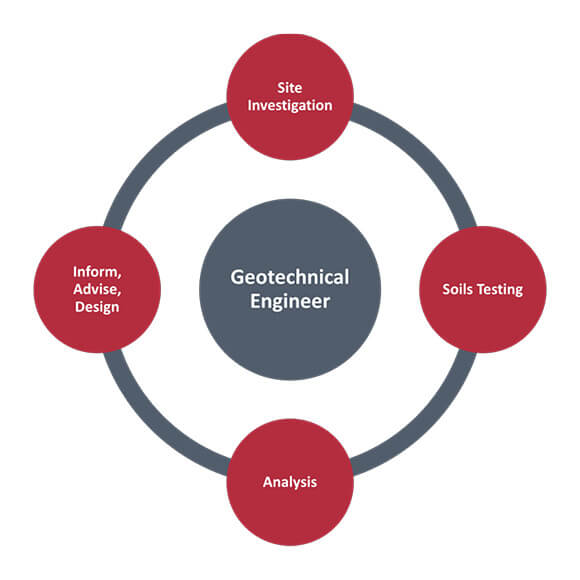Top Guidelines Of Geotheta
Top Guidelines Of Geotheta
Blog Article
See This Report about Geotheta
Table of ContentsSome Known Details About Geotheta The 10-Second Trick For GeothetaSome Known Incorrect Statements About Geotheta Some Of GeothetaFascination About Geotheta

They carry out site investigations, collect examples, perform research laboratory examinations, and assess information to examine the viability of the ground for building and construction jobs - Consulting Engineer. Based on their findings, geotechnical engineers offer referrals for foundation layout, slope stability, preserving structures, and reduction of geotechnical risks. They collaborate with various other experts, such as designers, structural designers, and building groups, to ensure that geotechnical considerations are integrated right into the total task style and implementation
By evaluating the behavior and residential or commercial properties of dirt and rock, they can determine possible geotechnical threats such as landslides, dirt negotiation, or slope instability. Their know-how aids protect against failings or mishaps that can endanger lives and residential or commercial property. Here are some comprehensive tasks and responsibilities of a geotechnical designer: Website Investigation: Geotechnical engineers conduct website examinations to gather data on subsurface problems.
They analyze the information to recognize the homes and habits of the dirt and rock, including their toughness, leaks in the structure, compaction characteristics, and groundwater conditions. Geotechnical Evaluation and Layout: Geotechnical engineers examine the data accumulated during website investigations to analyze the stability and viability of the website for construction jobs. They do geotechnical computations and modeling to evaluate aspects such as birthing capability, settlement, incline stability, side earth stress, and groundwater circulation.
Unknown Facts About Geotheta
Foundation Style: Geotechnical designers play a critical function in developing structures that can safely support the designated framework. They evaluate the dirt conditions and lots requirements to establish the suitable structure type, such as shallow structures (e.g., footings), deep structures (e.g (https://geotheta.wordpress.com/2024/08/02/unlocking-the-secrets-of-geotechnical-engineers-the-geotheta-advantage/)., piles), or specialized strategies like dirt improvement. They take into consideration aspects such as settlement restrictions, birthing capacity, and soil-structure communication to develop optimal structure styles
They evaluate construction plans, display site tasks, and perform field inspections to validate that the design referrals are complied with. If unforeseen geotechnical problems arise, they analyze the circumstance and provide suggestions for removal or adjustments to the layout. Threat Evaluation and Reduction: Geotechnical designers assess geotechnical risks and threats connected with the task site, such as landslides, liquefaction, or dirt disintegration.

Collaboration and Interaction: Geotechnical engineers function closely with various other professionals associated with a task, such as architects, structural designers, and construction groups. Effective interaction and partnership are important to incorporate geotechnical considerations right into the overall job design and building and construction procedure. Geotechnical engineers give technological experience, solution queries, and make sure that geotechnical demands are satisfied.
The Facts About Geotheta Revealed
Right here are some kinds of geotechnical designers: Structure Designer: Structure designers specialize in developing and examining foundations for structures. They evaluate the soil conditions, load requirements, and site attributes to figure out the most proper foundation type and design, such as superficial structures, deep structures, or specialized methods like pile foundations.
They review the variables affecting incline stability, such as dirt residential or commercial properties, groundwater conditions, and incline geometry, and establish strategies to stop slope failings and minimize risks. Earthquake Engineer: Quake designers concentrate on analyzing and developing structures to hold up against seismic pressures. They assess the seismic threat of a website, examine dirt liquefaction possibility, and establish seismic layout criteria to make certain the safety and security and strength of structures throughout quakes.
They execute area screening, gather samples, and examine the collected information to identify the soil buildings, geologic formations, and groundwater conditions at a site. Geotechnical Instrumentation Engineer: Geotechnical instrumentation engineers concentrate on surveillance and gauging the behavior of soil, rock, and frameworks. They set up and preserve instrumentation systems that keep an eye on variables such as soil settlement, groundwater levels, slope movements, and structural variations to analyze efficiency and give early cautions of prospective problems.
What Does Geotheta Do?
They conduct examinations such as triaxial examinations, consolidation examinations, direct shear examinations, and permeability tests to gather data for geotechnical evaluation and layout. Geosynthetics Engineer: Geosynthetics engineers concentrate on the design and application of geosynthetic products, such as geotextiles, geogrids, and geomembranes. They make use of these materials to improve dirt stability, reinforce inclines, offer drain options, and control erosion.
They often tend to be investigative individuals, which indicates they're intellectual, introspective, and analytical. They wonder, methodical, rational, logical, and logical. A few of them are also social, indicating they're kind, generous, cooperative, client, caring, useful, understanding, skillful, and pleasant. Does this noise like you? Take our free occupation test to learn if geotechnical engineer is among your top occupation suits.
In the office environment, geotechnical engineers make use of specialized software application tools to execute estimations, produce styles, and evaluate data. They prepare records, testimonial project requirements, interact with customers and team participants, and coordinate job activities. The office setup gives a helpful atmosphere for research study, evaluation, and cooperation with other specialists included in the task.
The Basic Principles Of Geotheta
They frequently check out project websites to conduct website investigations, evaluate geotechnical problems, and gather data for analysis. These gos to entail traveling to different places, sometimes in remote or difficult surfaces. Geotechnical designers might perform dirt tasting, conduct tests, and screen building and construction tasks to guarantee that the geotechnical aspects of the job are being executed correctly.
Geotechnical engineers additionally operate in specialized geotechnical laboratories. In these facilities, they carry out experiments, do examinations on dirt and rock samples, and examine the design properties of the products. Geotechnical laboratory engineers work extensively in these atmospheres, handling testing Discover More devices, operating instruments, and tape-recording data. They work together with other lab personnel to make certain accurate and trustworthy screening outcomes.
Report this page